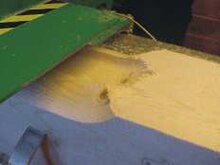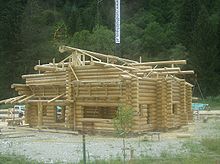Log house moulder

A log house moulder is a machine used to shape logs for building a log home. Shaping creates the correct profile for stacking and joining logs. This process may involve removing the bark, milling into a cylinder, and/or planing into flat surfaces. Log house moulders may be machines capable of processing large volumes of unlimited length logs, or more portable units which leverage a chainsaw as a motor.
Capabilities
Industiral log through-pass moulders centralize several steps of wood preparation, weighting up to 11,000 kilograms and able to process up to 1,000 meters of logs per 8 hours[1]. Barked or debarked green or dry logs are fed into such a machine one after other. Logs are milled into shape which, depending on style, results in cylindrical or square beams[1]. These different profiles are customizable depending on construction method: Swedish cope, Tongue&groove, D-log, bevel-edged, etc. This configuration is accomplished through affixing different saw teeth to produce flat, curved, or notched cuts[2][3]: 7 . While permanent log house moulders are powered by electricity, portable sawmills use a chainsaw driven milling cutter[3]: 1 .

References
- ^ a b Rotary Log Mill, December 12, 2024, archived from the original on October 21, 2009, retrieved 2024-12-12
- ^ Log House Molder for Sawmills, December 12, 2024, archived from the original on May 10, 2006, retrieved 2024-12-12
- ^ a b LOGOSOL User Manual, December 12, 2024, archived from the original on December 12, 2024, retrieved 2024-12-12
